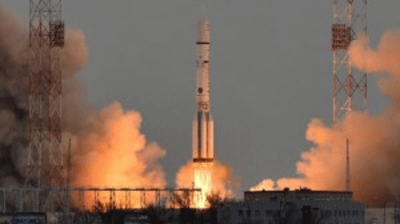Mars TGO mission heads for Red Planet on methane quest

Europe and Russia have launched a joint mission to the Red Planet.
The satellite, called the ExoMars Trace Gas Orbiter (TGO), lifted off from Baikonur in Kazakhstan at 09:31 GMT.
The probe will investigate whether the methane in the world's atmosphere is coming from a geological source or is being produced by microbes.
If all goes well, the two space powers expect to follow up this venture with a rover, to be assembled in the UK, which will drill into the surface.
That could launch in 2018, or, as seems increasingly likely, in 2020.
It takes several hours to put the satellite on the right trajectory to go to Mars.
A series of engine burns by the Proton rocket's Breeze upper-stage are required to build up the velocity needed to break free of Earth's gravity.
By 13:30 GMT, it was confirmed that three of these firings had occurred, with one last effort scheduled for late in the evening on Monday.
The flight sequence has strained the nerves of space agency officials. There have been many anxious but excited conversations during the day here at the European Space Agency's mission operations centre in Darmstadt, Germany.
For Russia especially, the Red Planet represents a destination of wretched fortune.
It has previously launched 19 missions to the fourth planet from the Sun, and most of those have been outright failures.
Many could not get off the pad cleanly; others simply stalled above the Earth and fell back down; a few crashed and burned at Mars or sailed straight past.
Assuming everything works out this time, controllers in Darmstadt can expect a first signal from the TGO after it has been released on its way by the Breeze stage.
This should come through at 21:28 GMT. It is then a seven-month cruise to Mars.
Three days out from arrival, on 16 October, the satellite will eject a small landing module known as Schiaparelli.
Once on the surface, on 19 October, its aim is to operate a few science instruments, but engineers are primarily interested to see how the module performs during the entry, descent and touchdown.
In particular, Schiaparelli will showcase a suite of technologies - radar, computers and their algorithms - that will be needed to put a later, British-built rover safely on the planet.
This second step in the joint European-Russian ExoMars project is supposed to leave Earth in 2018, although this is now looking increasingly doubtful because of funding and scheduling issues. Many connected with ExoMars are now talking about 2020 as being a more realistic launch date.
None of this affects the TGO mission, however.
After it has dropped off Schiaparelli, the satellite will spend the better part of a year manoeuvring itself into a 400km-high circular orbit above Mars.
From this vantage point, the orbiter's state-of-the-art instruments will then make a detailed inventory of Mars' atmospheric gases.
Methane is the key interest. Previous observations - by satellite, Earth-based telescopes and America's Curiosity rover on the surface of the planet - found the hydrocarbon to be present in very low concentrations, at just a few parts per billion by volume.
That it is there at all is surprising. Ultraviolet light should remove the gas from the atmosphere within a few hundred years, which suggests it must be replenished somehow.
One possible active source involves geological activity at depth, where water could be reacting with rock minerals to produce hydrogen, which is then further processed into methane.
Another tantalising prospect is that the source is biological in origin.
Most of the methane in Earth's atmosphere comes from microbes, like those in the stomachs of ruminants.
There are no cows on Mars, but simple organisms could conceivably be operating just below the surface of the planet.
The TGO's measurements should throw some light on these competing ideas.
BBC















